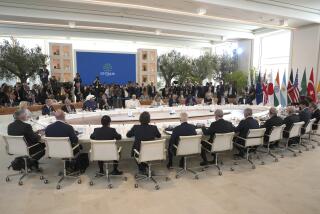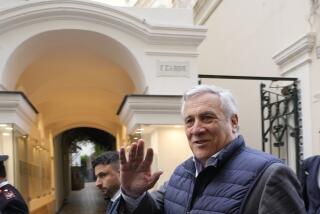U.S. to Broach Auto Trade Issue With Japan at G-7 : Summit: In a turnaround, Clinton says he will try to resolve the dispute when the seven major industrial democracies meet.
WASHINGTON — President Clinton said Wednesday he will press ahead with discussion of the U.S. trade dispute with Japan over automotive trade when he meets today with Japan’s Prime Minister Tomiichi Murayama at the summit of industrial nations in Halifax, Nova Scotia.
The White House had been insisting the two leaders would not even discuss the contentious auto issue at the Group of Seven summit. But Japan’s agreement Wednesday to hold further discussions in Geneva next week appeared to raise hopes of movement in what has been a standoff as a June 28 deadline nears for the imposition of stiff U.S. sanctions against Japanese luxury cars.
“I believe we can reach a successful conclusion and I intend to do everything I can to see that it is done,” Clinton said at a news conference with French President Jacques Chirac.
The leaders of the seven major industrial democracies are opening their annual summit conference tonight under the darkening cloud of the angry U.S.-Japan trade dispute while the leaders search, instead, for global economic cooperation.
Earlier, Administration officials said there was a “zero chance” that the two leaders would tackle the auto dispute in this meeting. But the White House took heart in Japan’s agreement to meet with senior Clinton aides in Geneva.
They viewed it as a step away from Tokyo’s earlier insistence that it will not
negotiate under the threat of sanctions.
The auto affair is not on the agenda of the seven-nation summit itself, whose topics will range from economic measures to prevent the sort of collapse that nearly shattered Mexico--and that caught financial markets and many in the Clinton Administration by surprise--to the failed efforts to end the civil war in Bosnia, to the U.S.-led campaign to further isolate the renegade regime in Iran.
But aside from a nearly completed declaration that they will cooperate in creating an emergency fund to prop up failing economies--much as an international effort led by the United States bailed out Mexico in January and February--Clinton and his summit partners have set modest goals for the 21st annual economic summit conference of the world’s richest nations.
The sites for the meetings could be reflective of both the unassuming goals and the dangerous shadow of the trade battle: first, a modern, seven-story glass office building that sits so squat and plain on the Halifax harbor that it is known locally as the Green Toad, and, for the reading of a declaration on the world economy, a maritime museum that houses a deck chair retrieved from the flotsam of the Titanic.
The goals being addressed by the Group of Seven represent a pronounced shift from those in previous years, when the summits set agendas intended to bring the global economy out of recession or, before that, to tame inflation--targets that were largely out of the realm of any one nation, even the economic giants.
As presented by Treasury Secretary Robert E. Rubin and other U.S. officials, the overriding theme will be how to cope with the shifts that technology and growing wealth and investment have forced on the international economic system in recent years.
The need to take such steps was driven home by the Mexican crisis. But the difficulty in paying for any concrete plan, such as the emergency fund--in effect a rapid dollar deployment force--did not take into consideration the anti-foreign-aid mood that has overtaken the Congress.
Indeed, Clinton Administration officials speaking readily about the emergency fund turn quickly coy when asked how they will coax out of Congress the multibillion dollars needed for the package. They acknowledge, as Rubin did last week, that “there is a new isolationism afoot, and it must be aggressively countered.”
Among the summit’s key goals, according to a draft of the communique the seven nations will issue on Friday, are greater surveillance of economic trends to avoid the sort of surprises that Mexico sprung by keeping track of foreign exchange reserves; establishment of an “emergency financing mechanism” to provide speedy access to currency-stabilizing dollars for countries that find themselves approaching bankruptcy, and an expansion of the International Monetary Fund’s existing operations.
The summit’s goals concern big-picture global policy, but the leaders will nonetheless be meeting in the shadow of a nitty-gritty trade dispute that is shaking the roots of international commerce.
In its effort to pressure Japan to buy more U.S. autos and auto parts, the Administration has said that it will impose 100% tariffs on 13 top-of-the-line Japanese auto models, beginning June 28.
The U.S.-Japanese trade picture has darkened further over a complaint by Kodak that Tokyo is blocking its efforts to sell photo supplies in Japan and a complaint by Federal Express that Japan is violating a 1952 agreement by insisting that certain routes on the cargo airline’s proposed new Asian schedule require Japanese approval.
Against that backdrop, Administration officials say they are concentrating on such areas of seeming success as the goal, shared by Washington and Tokyo, of restraining North Korea’s nuclear weapons program.
Reuters contributed to this report.
More to Read
Sign up for Essential California
The most important California stories and recommendations in your inbox every morning.
You may occasionally receive promotional content from the Los Angeles Times.










